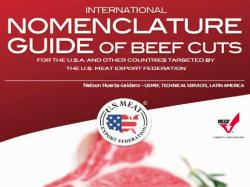USMEF Develops International Beef Cuts Nomenclature Guide
October 31, 2013 | 2 min to read

As more and more countries adopt regulations requiring that U.S. red meat exports include labels printed in the language of the country of destination, the U.S. Meat Export Federation (USMEF) – contractor to the Beef Checkoff Program – has completed an International Nomenclature Guide of Beef Cuts that provides equivalent names for the most common U.S. beef cuts for 33 different countries and regions, as well as comparable names for lesser-known value cuts in selected Latin American markets.
“Globalization of the meat industry and the multiplicity of terms used in international meat trade has complicated our industry,” said Dr. Nelson Huerta Leidenz, director of technical services for USMEF-Latin America, who spearheaded the project with USMEF staff and industry support from the U.S., China, the EU, Japan, Mexico, the Middle East, Panama, Russia, South America, South Korea and Taiwan. “Our goal is to give exporters a ready reference for those cuts that are most commonly traded so that bilingual labeling will not be an issue.”
English and Spanish versions of the guide are online. Questions about the Nomenclature Guide can be directed to Dr. Huerta at nhuerta@usmef.org.mx.
For more information about your beef checkoff investment in foreign marketing efforts, visit MyBeefCheckoff.com.
The Beef Checkoff Program was established as part of the 1985 Farm Bill. The checkoff assesses $1 per head on the sale of live domestic and imported cattle, in addition to a comparable assessment on imported beef and beef products. States retain up to 50 cents on the dollar and forward the other 50 cents per head to the Cattlemen's Beef Promotion and Research Board, which administers the national checkoff program, subject to USDA approval.
Source: The Beef Checkoff Program
